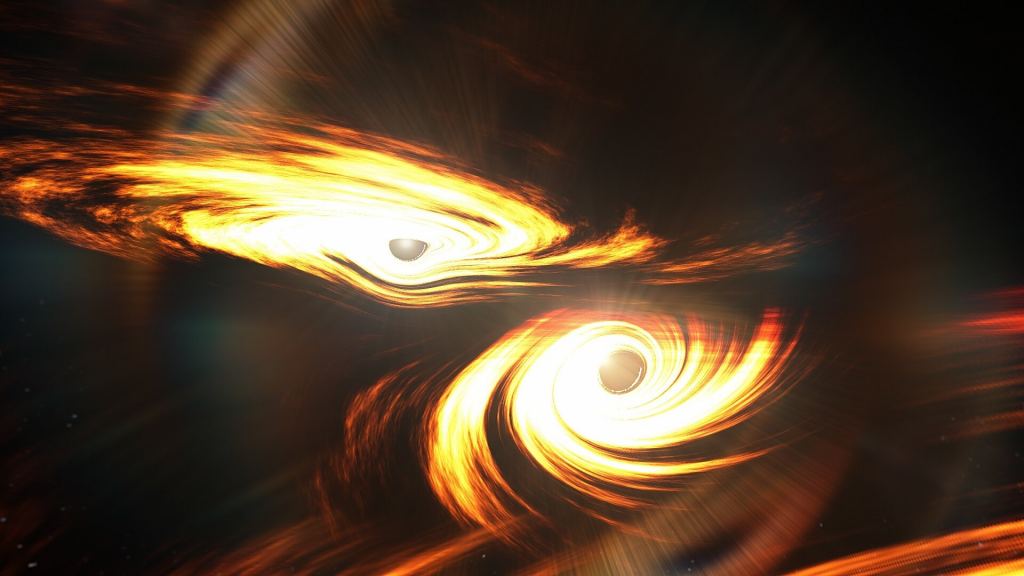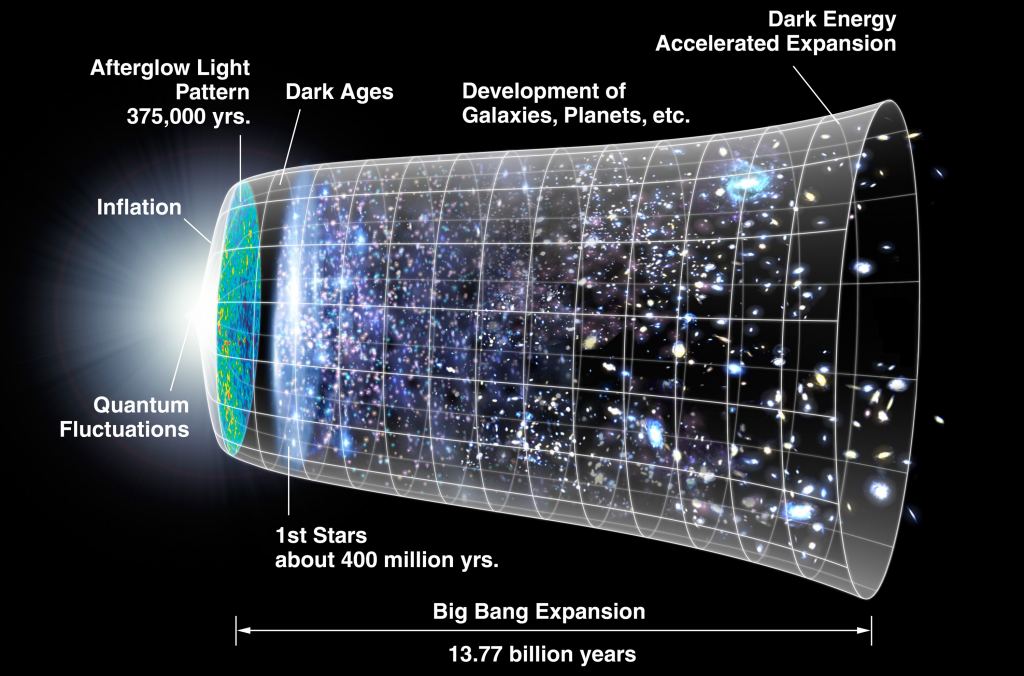By the 1920s, astronomers learned that the Universe was expanding as Einstein's Theory of General Relativity predicted. This led to a debate among astrophysicists between those who believed the Universe began with a Big Bang and those who believed the Universe existed in a Steady State. By the 1960s, the first measurements of the Cosmic Microwave Background (CMB) indicated that the former was the most likely scenario. And by the 1990s, the Hubble Deep Fields provided the deepest images of the Universe ever taken, revealing galaxies as they appeared just a few hundred million years after the Big Bang.
Over time, these discoveries led to an astounding realization: the rate at which the Universe is expanding (aka. the Hubble Constant) has not been constant over time! This led to the theory of Dark Energy, an invisible force that counteracts gravity and causes this expansion to accelerate. In a series of papers, an international team of researchers led by the University of Hawaii reported that black holes in ancient and dormant galaxies were growing more than expected. This constitutes (they claim) the first evidence that black holes could be the source of Dark Energy.
The research was made up of astronomers and astrophysicists from the University of Hawai'i, the Kavli Institute for Cosmological Physics, the Enrico Fermi Institute, the European Southern Observatory (ESO), the Netherlands Institute for Space Research (SRON), the National Radio Astronomy Observatory (NRAO), the Instituto de Astrofísica e Ciências do Espaço (IA), the Mitchell Institute for Fundamental Physics and Astronomy, and multiple universities. Their findings appeared in two papers published in *The Astronomical Journal* and The Astronomical Journal Letters.
Cosmological Crisis
According to the most widely accepted model of the Universe, Dark Energy accounts for 68% of the mass-energy content in the Universe. This theory resurrected an idea Einstein had proposed but later rejected – that there was a " Cosmological Constant " (represented by the scientific symbol delta) that "held back" gravity and prevented the Universe from collapsing in on itself. The force and Dark Matter (which accounts for 26.8% of the mass-energy content) are integral to the most widely held cosmological model today, known as the Lambda-Cold Dark Matter (LCDM) model.
The main argument behind Dark Energy is that there is a special type of energy within spacetime (called vacuum energy) pushing the Universe apart. There are a few problems with this theory, though, not the least of which has to do with the fact that no direct evidence exists for this mysterious energy. Moreover, while this vacuum energy is consistent with quantum mechanics, all attempts to calculate it using quantum field theory have come up dry. On top of that, there is the question of how this energy coincides with supermassive black holes (SMBHs) in our Universe.
By the 1970s, astronomers had determined that the persistent radio source at the center of our galaxy (Sagittarius A*) was a black hole with a mass of 40 million Suns. Further observations demonstrated that most massive galaxies had SMBHs in their core region, which was the reason for Active Galactic Nuclei (AGNs), or quasars. The extremely powerful gravity of SMBHs causes surrounding matter to infall around them, forming accretion disks and powerful relativistic jets where matter is sped up to close to the speed of light (and releases tremendous amounts of radiation in the process).
The presence of these mammoths at the center of most massive galaxies would require an extremely strong force to counteract them. This is particularly true when it comes to the singularities theorized to exist at their cores, where the very laws of physics break down and become indistinguishable. This gave rise to an exotic theory known as "cosmological coupling," which states that SMBHs might have tremendous vacuum energy and that they are the reason the Universe is expanding.
Extraordinary Claims...
In their papers, the team led by Duncan Farrah (an astronomer with the University of Hawai'i at Manoa and a former Ph.D. with Imperial College report the first observational evidence that black holes gain mass in a way consistent with them containing vacuum energy. Whereas astrophysicists have been looking for a theoretical resolution to the problem of Dark Energy and Black Holes, the team's findings allegedly constitute the first observational evidence that black holes are the source of Dark Energy.
If true, the finding removes the need for singularities to form at the center of black holes, resolving a long-standing debate. It also means that nothing more is needed (no new forces or modified theories of gravity) for our cosmological models to make sense. Dr. Chris Pearson, a researcher from RAL Space, a research council overseen by the UK's Science and Technology Facilities Council (STFC), and Dr. Dave Clements of the Department of Physics at Imperial College were co-authors on the studies.
"If the theory holds, then this will revolutionize the field of cosmology, because at last we've got a solution for the origin of dark energy that's been perplexing cosmologists and theoretical physicists for more than 20 years," said Pearson in a RAL Space press release. "This is a really surprising result. We started off looking at how black holes grow over time, and may have found the answer to one of the biggest problems in cosmology," added Clements.
...Require Extraordinary Evidence
The team reached this conclusion by examining the evolutionary history of SMBHs at the center of giant elliptical galaxies. This refers to a type of "early galaxy" that formed early in the Universe and has since ceased forming stars (aka. "dormant galaxies"). Decades of observations have shown that black holes can increase their mass in two ways: by accreting matter or by merging with black holes. As they indicated in their first paper, the team examined giant elliptical galaxies at redshifts of less than z<2 (as they appeared nine billion years ago).
These dormant galaxies have little material left for their SMBHs to accrete, meaning that further growth cannot be explained by the two mechanisms mentioned above. The team then compared observations of these elliptical galaxies - which still appear young - to local galaxies dated to ca. 6.6 billion years ago, which have since become dormant. These observations revealed that the SMBHs were 7 to 20 times larger than they were nine billion years ago, much greater than what is predicted by accretion or mergers.
In their second paper, they further state how measurements of related populations of galaxies at different points in their evolution (ca. 7.2 billion years ago) showed a similar correlation between the mass of SMBHs and the size of the Universe. This constitutes the first evidence of "cosmological coupling" by showing that the expansion of the Universe and the growth of SMBHs are related. If this is born out by further observations, it could effectively redefine our understanding of the Universe and the nature of black holes. As Farrah concluded:
"We're really saying two things at once: that there's evidence the typical black hole solutions don't work for you on a long, long timescale, and we have the first proposed astrophysical source for dark energy. What that means, though, is not that other people haven't proposed sources for dark energy, but this is the first observational paper where we're not adding anything new to the Universe as a source for dark energy: black holes in Einstein's theory of gravity are the dark energy.''
Correlation, not Coupling?
Naturally, these claims have been met with some skepticism by the astronomical/astrophysical community. In particular, the authors' claim that their observations constitute proof of coupling has been challenged for conflating correlation with causation. Astrophysicist, author, science communicator, and Forbes senior contributor Ethan Siegel addressed this in a recent installment of *Ask Ethan* - a special series in his column Starts with a Bang!, where he addresses audiences' questions. Upon examining their research, Siegel notes how the authors' conclusions rest upon a major assumption.
This assumption is that there is "a universal relationship between the mass of the central black hole and the mass of the stars within a galaxy, which can evolve over cosmic time but should be universal at any particular time." From this, they compared the SMBHs they chose for their sample data to determine whether there is a "coupling parameter" (represented as k) that has the same value across cosmic time. In the end, the team determined with a confidence of 99.8% that k has a non-zero value. While ostensibly compelling, this conclusion comes down to an assumed relationship. As Ethan concluded:
"The authors are assuming the existence of a coupling that isn't there and ascribing the perceived evolution of the black hole-to-stellar mass ratios to a coupling, when what's happening is these galaxies and their black holes are evolving. Since we're only measuring each galaxy at a 'snapshot' in time, we have no way of knowing how any individual object is evolving, and this particular method is precisely how the article authors are fooling themselves, and by extension, anyone who believes them."
At the risk of repeating the overused adage, "extraordinary claims require extraordinary evidence." The ability to verify results repeatedly is one of the most important qualifiers for evidence to be considered sound. In other words, results must be demonstratable again and again and (preferably) using varying methods. The authors acknowledge this and hope that repeated observations will bear them out. But for the time being, the claim they've made remains extraordinary and (given the implications) demands further investigation.
Further Reading:
- *RAL Space*
- Starts with a Bang!
- *The Astrophysical Journal*
- *The Astrophysical Journal Letters*
 Universe Today
Universe Today


